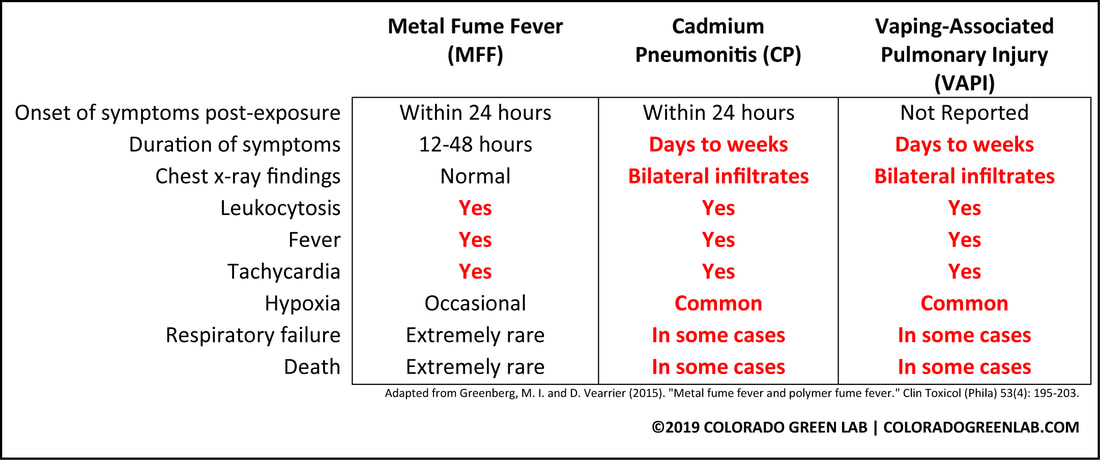Vitamin E acetate has pretty much been eliminated as the lone cause of the vaping illness that has claimed at least 27 lives and hospitalized 1,300 people. With vitamin E acetate off the table as the vape illness culprit, there’s a new suspect in the ongoing mystery: cadmium pneumonitis, a rare lung disease caused by inhaling heavy metal fumes.
In a blog post published this week by Colorado Green Lab, cadmium pneumonitis, an extreme form of metal fume fever, presents many, if not most, of the symptoms that match those associated with the vaping illness, which has been dubbed vaping associated pulmonary injury (VAPI). Colorado Green Lab’s study was developed and led by one of the lab’s co-founders, Frank Conrad, who is an experienced biochemist.
Gallery — These Are Fake Vapes:
Conrad isn’t the first scientist to suspect that heavy metals could be causing VAPI, but he is the first to propose that a specific metal — cadmium — could be behind the recent health crisis.
“In our study, we’ve identified common, but subtle, variations in 510 cartridge threading design that correlate with airflow and venting performance across the series,” Conrad wrote to MERRY JANE in an email. “The variations in thread design directly relate to manufacturing cost and retail price of the cartridges. The least complex cartridge design is also the cheapest to manufacture and the most ubiquitous type on the market.”
In other words, VAPI is likely the product of unregulated vape producers relying on the cheapest materials to keep their costs low while maximizing their profits.
“Cadmium alloy solder is one of only a few likely agents that can also cause the range of symptoms described in VAPI patient data sets,” Conrad added.

His suspicions could give investigators new insight into what’s causing VAPI, considering some of the previous leads have gone nowhere. Last month, health authorities began looking into vitamin E acetate — an oil thickening agent that is used in unregulated, black market vapes but not in regulated ones — as a possible cause of the illness.
Vitamin E acetate can contribute to a lung illness called lipoid pneumonia, but it doesn’t account for other symptoms seen in VAPI patients. According to the vitamin E hypothesis, vaporizing vitamin E acetate could form an oily build-up in the lungs. Once enough oil clogs the lung’s air sacs, breathing becomes difficult if not impossible. However, lung biopsies from 17 VAPI patients haven’t shown any oily build-up in the lung tissue, which led to the Mayo Clinic’s conclusion that the illness is actually due to “chemical burns” and not oil buildup. Some analyses have shown that certain immune cells in the lungs of vape illness patients are covered in nanoscopic oil droplets, which is abnormal, but should not obstruct the ability to breathe.
Gallery — Dank Vapes & Cereal Carts Packaging Sold Online:
Furthermore, Colorado Green Lab’s proposal fits well with what we do know about the vaping illness crisis. People have been vaping nicotine products for over a decade. Cannabis vapes have also been around for years, but they grew in popularity after Colorado and Washington State launched the country’s first recreational cannabis markets in 2014. Yet the vaping illness crisis occurred very recently, which suggests that some new vape contaminant is causing it.
Authorities have not determined if the contaminant is in the vaping oil, also known as vape juice, or if it’s in the vaping device itself. MERRY JANE reached out to the CDC regarding cadmium pneumonitis and VAPI, but the agency did not respond before publishing time. Colorado Green Lab’s cadmium hypothesis states that the problem is likely not based in the oil, but in the hardware, specifically around the heating element or battery which enables the device to reach temperatures high enough to vaporize the oil.
The cadmium composes part of the silver soldering material used to fuse the heating element’s parts together. Licensed and legal vape devices do not use cadmium because of this heat-leeching issue. One UK study provides some support to Conrad, as it found that most commercially available vape devices produce heavy metal fumes.
If a heavy metal such as cadmium is causing VAPI, the health crisis may not end anytime soon. That’s because cadmium has a bad habit of sticking around in the human body. “Cadmium has an excretion half-life of 10 to 30 years,” Conrad wrote, “and if confirmed as the causal agent of VAPI, patients may be at risk for kidney damage long after the respiratory syndrome has resolved.”
Conrad and Colorado Green Labs will soon publish the second part of their series on VAPI and cadmium. The second part, titled “Vivisection of a Vape Pen,” will look at how vape devices are constructed, and how that construction could explain what’s causing VAPI — and, ultimately, provide a solution to the crisis.
Gallery — Mario Carts Packaging Sold Online:
Follow Randy Robinson on Twitter











